Simulation of Cloud Formation
Pingfei Chen
1. Introduction
Modeling clouds is very difficult because of their complex, amorphous
structure [1]. A Model based on laws of fluid mechanisms is impractical
because solving the Navier-Stokes equation in 3D is very costly [6]. The
surface-based cloud models can be used to simulate the overall shape of
clouds but it couldn't describe 3D structure. Therefore, a volumetric
model must be used [1]. However, a volumetric denisity-based technique
for clouds is impractical because it is extremely difficult for an animator
to specify the detailed 3D density of a cloud model. Dr. Ebert has
proposed a new powerful cloud model called volumetric procedural modeling,
which combines traditional volumetric procedural models with implicit functions
[1]. It takes the advantages of both these techniques . The model proposed
by Dr. Ebert describes the cloud as two level structures: its macrostructure
and its microstructure, which are modeled by implicit function and turbulence,
respectively.
In this project, a modified particle system is used
to generate ``band'' clouds, which are altocumulus. The basic
idea is to allow only part of particle to move. The dynamic and static
features of this approach make it possible to control inserting, merging
and splitting waves, but there are some artifacts in the final image.
Another type of a cloud simulated is a cloud which I call ``puffy'' cloud
because of its appearance. To simulate the blocks of ``puffy'' cloud,
a group of sub particles are used to describe a block and its attributes
are controlled in order to get realistic images. However, the results
have some artifacts.
The other more important part of the project
is to simulate the formation of cumulus. A particle system is used to simulate
high level structure of a cloud. Then, the powerful rendering program ``avoid''
provided by Dr. Ebert is used to produce the final images.
2. Background
The earlier geometric models, such as polygonal models, patches,
points and lines, which work well in some situations, can not deal with
the complexities of natural objects such as highly detailed mountains and
clouds [7]. Therefore, higher level modeling techniques have been developed
to provide an abstraction of the models. Most of these advanced modeling
approaches use code segments or algorithms to abstract the details
of model in order to avoid explicitly storing vast numbers of low-level
primitives. These advanced modeling approaches provide great flexibility
and data amplification. Another important feature of these
approaches is to allow us to go beyond the law of physics and to generate
more realistic images. There are several types of procedural advanced geometric
modeling techniques, including fractals, grammar-based models, volumetric
procedural models, implicit surfaces and particle systems [7]. Fractals,
grammar-based models, and implicit surfaces are surface-based modeling
techniques. Volumetric procedural models and particle systems are volumetric
modeling techniques.
In order to model a cloud,
semi-transparent surfaces were used to produce convincing images of clouds
in many previous approaches. Gardner[10] proposed textured ellipsoids covered
with a procedural noise opacity which fades on the horizon of the shape.
However, the generated cloud is inaccessible. To capture the three-dimensional
structure of the cloud, volumetric density-based models must be used [1].
Kajiya produced the first volumetric cloud model in computer graphics,
but the results were not realistic. Stam, Fosterm and Ebert have produced
convincing models of smoke and steam. Neyret has recently proposed a way
to model connective cloud based on general physical characteristics. However,
Neyret didn't use volumetric modeling [6].
Dr. Ebert [1] has proposed
a powerful, flexible approach called volumetric procedural modeling, which
combines traditional volumetric procedural models with implicit functions
to create a model that has the advantages of both these techniques. Implicit
surface [7] is surface of constant value, created from blending primitives
represented by implicit equation. Implicit functions have been used for
many years as a modeling tool for creating solid objects and smoothly blended
surfaces. However, modeling complex shapes is still a difficult task for
volumetric shapes. Volumetric density-based models have been used effectively
to capture the three-dimensional structure of clouds, but it is extremely
difficult to specify and control the detailed three-dimensional density
of a cloud model. Dr. Ebert has combined these two techniques to get a
new model which has two main components: the cloud macrostructure
and the cloud microstructure. These two main components are modeled
by implicit functions and turbulent volume densities. A particle
system is suggested to be used for volumetric procedural implicit
particles.
3. Simulations of Clouds
3.1 The general knowledge of clouds
The cloud is comprised of visible ice crystals and/or water droplets
suspended in air [4]. Clouds can be big or little, thick or thin, existing
in a seemingly endless array of shapes and sizes. The clouds can be classified
as high cloud mid level clouds, low-level clouds, connective clouds, and
other types of clouds [4].
3.2 ``Band'' Cloud
To simulate the band clouds, several approaches can be used. The straightforward
way is to use sine function. By using sine function, the initial shape
of a cloud is formed, then turbulence is added at original positions. However,
there are some drawbacks in this approach . First, the number of waves
is fixed. But, when you take a close look at the picture, you will note
that the number of waves is actually variable. Second, it is difficult
to insert a new wave between consecutive waves because of turbulence.
Third, it is hard to merge two consecutive waves.
In this project, a modified particle system approach
is proposed to solve the above mentioned problems. A particle system
is a collection of primitives which has the following typical attributes:
position, velocity, color, lifetime and transparency. In this approach,
only part of particles, which I call "fresh" particles, are allowed to
move instead of all particles. Three rules for the movement
of a particle are defined in this approach.
The first one is that, suppose a particle P moves
from position p1 to p2, then the particle leaves a copy of P at the position
p1 and the copy lost its ability for further movement. Here, assume that
a small turbulence is allowed. The particle at position p2 which is "fresh"
can move at the next time and its lifetime decreases by 1. The next time,
suppose the particle at position p2 moves from p2 to p3. By using the same
way that used for the movement from P1 to P2, one more copy leaves at the
position p2 and it can not move anymore and the particle at position p3
becomes "fresh" and its lifetime decreases by 1.
The second one is that a particle may be split
into several particles first, then these particles move to different positions,
where "fresh" particles are born, and only one copy is left at the original
position.
The third one is that two or more "fresh" particles
may merge into a new particle according to the relative distances
among them.
Based on the above three rules, a "band" cloud can
be simulated like this: start with several particles, which have
the same coordinate x (y and z can be arbitrarily). In order
to compute the vertical distance easily, the same speed are assigned
in X coordinate for these particles so that, at the next time, the particles
can arrive at the same plane. Thus, it is easy to add a new wave
or merge two waves according to the vertical distance. The experiments
in this project demonstrate the feasibility of this approach for
solving insertion and merging but the final image produced by this approach
has some artifacts.
3.3 ``Puffy'' Cloud
A "puffy'' cloud can be described as following:
a "puffy" cloud consists of a lot of thick blocks
which are separated by a lot of holes. These blocks have very complex shapes
and different sizes. Also they are connected as a whole.
To simulate the holes, a lattice is used to make
some of locations empty and a parameter, which represents the ratio( blocks
/ holes ), is also used to control this ratio. Particles can be used
to describe the blocks. If a block is represented just
by one particle, it may fail to describe block's complexity. A group of
particles are needed to describe a block. The reason is that the complexity
of a block's shape might be described by a few of sub particles instead
of one particle. In the project, several attributes such as number
of sub particles, relative location to the original position for
each sub particle, and size, are used for each block.
3.4 Simulation of Cumulus
Qualitative simulations of convective cloud formation and evolution
have been made by Neyret. These simulations are based on some specific
structures such as Rayleigh-Taylor instability, bubbles, columns, turrets,
Lelvin-Helmholtz instability, vortices, and Benard cells. This macroscopic
approach may not be physically-accurate, but it reduces the cloud complexity.
The model he proposed includes bubble generation, cloud evolution, and
small scale shape. We simulated the cloud macrostructure based on Neyret's
model and a particle system.
The formation of clouds can be described as
the following: a bubble is generated on the ground, then it rises
due to the force generated by the gradient temperature difference. As it
rises, it grows and may merge with other bubbles. At some altitude, it
cools off and can be separated into small visible particles. Then it keeps
going until it can't move. A bubble can be described by a particle, which
has several attributes such as position, radius, velocity, and lifetime.
By generating new particles and moving particles according to their speed,
a high level structure of a cloud can be obtained. The control of their
speeds is very important to the shape of a cloud. My simulation program
is based on the above formation process. It produces data files for "avoid"
program to generate images. The procedure of this program is listed as
the following:
produce some initial small bubbles with lifetimes,
radius, position, and speed
For each frame
For each bubble
update each primitive particle according to its speed increase its
radius if its lifetime is greater than zero
reduce its up speed a little bit due to friction
decrease its lifetime maybe produce new child bubble and initialize
the new bubble's attribute
end for each bubble
write out all the bubbles for this frame.
End for
The particle's attributes are updated according to the following
assumptions:
-
The up velocity of a bubble is decreased due to friction.
-
The size of a child bubble which has some attributes of its parent, is
smaller than that of its parent.
-
A bubble goes along the halfway between the cloud normal and the vertical.
4. Results
Figure 1 is a generated image for a "band" cloud. In this experiment,
the number of initial particles is 8 and total number of particle finally
goes to about 600. You can see the new waves are added naturally, the two
waves are merged naturally, and the waves are split ted to more waves,
but there are some artifacts.
Figure 2 is a generated image
for a ``puffy'' cloud. In this experiments, the number of particles is
about 4 or 5. The sizes of sub particles range from 0.2 to 0.5. The result
isn't good.
Some selected images from my last
animation can be seen from Figure 3 to Figure 8. The cloud formation is
shown
in these images.
5. Conclusion
In this project, a``band'' cloud is generated
using a modified particle system approach, which makes it possible
to control inserting, merging and splitting waves. However, there
are some artifacts in the final image.
By using a particle system and ``avoid'' program,
it is possible to get natural clouds.
The experiments in this project demonstrate
that the volumetric procedural modeling is powerful to model very complex
clouds .
6. Acknowledgments
The author would like to thank David Ebert for offering
constructive suggestions and evaluations.
Reference
[1] David Ebert, ``A Volumetric Procedural Cloud Model'' Spring
1998
[2] David Ebert, F.kenton Musgrave, Darwyn Peachey, Ken Perlin, and
Steve Worley. `` Texturing and Modeling : A Procedural Approach,'' Academic
Press, Oct. 1994.
[3] David S. Ebert. Advanced modeling techniques for computer graphics.
In CRC Handbook of Computer Science and Engineering, chapter 56. CRC,1997
[4] http://covis.atmos.uiuc.edu/guide/clouds
[5] "Particle Systems - A Technique for Modeling a class of Fuzzy Objects,''
SIGGRAPH', 1983, pp. 359-376. SIGGRAPH', 1983, pp. 359-376.
[6] Fabrice Neyret, ``Qualitative Simulation of Connective Cloud Formation
and Evolution'' In Eighteen International Workshop on Computer Animation
and Simulation. Eurographics, Sept., 1997.
[7] David S. Ebert. Advanced modeling techniques for computer graphics.
In CRC Handbook of Computer Science and Engineering, chapter 56. CRC,1997
[8] A. Watt and M. Watt, ``Advanced Animation and Rendering Techniques,''
Addison-Wesley, 1992.
images
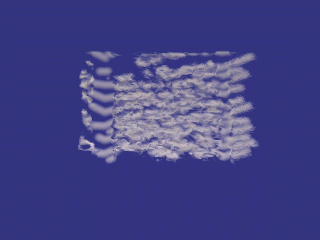
Figure 1

Figure 2
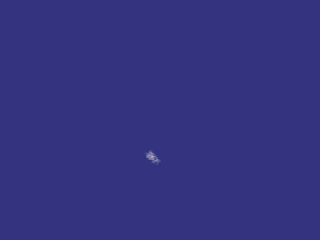
Figure 3
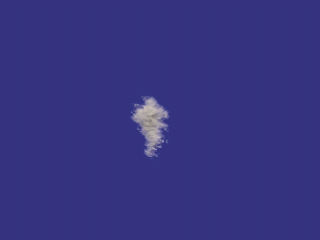
Figure 4
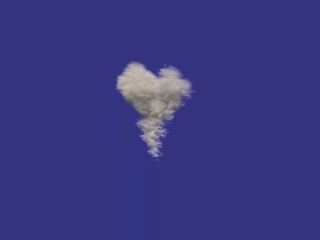
Figure 5
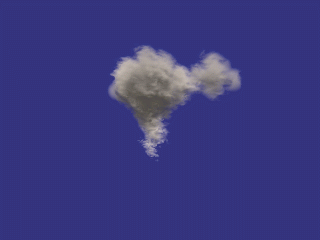
Figure 6
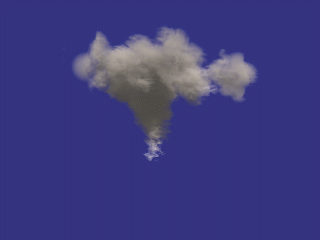
Figure 7
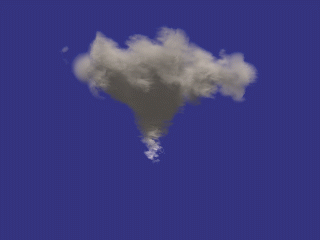
Figure 8







